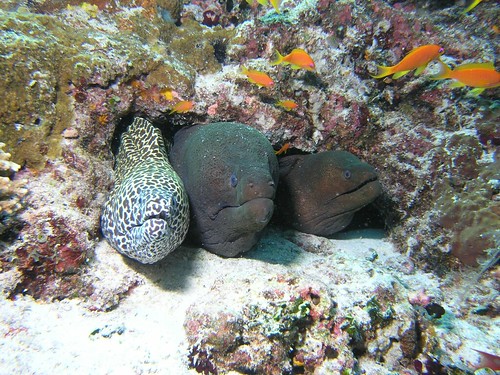
Giant moray (Gymnothorax javanicus) and Black-spotted moray (Gymnothorax isingteena), Maldives;
(Photo by le congre)
Inspired by this post on moray eels being sold for food in a local supermarket, I planned to do a short writeup on moray eel biology. It soon expanded to include discussions on why unagi should be avoided, and mention of other lesser-known eel families like the snake eels and pike conger eels, so much so that there was too much interesting information for a single post. And so, I've decided to do a series of posts instead, devoted to the Anguilliformes, or eels.
First up, the marvellous moray eels...
If anyone ever needs to look for information on moray eels online, Rick Macpherson is the person to go to. Rick writes the excellent blog Malaria, Bedbugs, Sea Lice, & Sunsets, and does a series of moray-themed posts entitled That's A Moray Monday. In his series, he has discussed such diverse topics such as general moray eel biology, reproductive behaviour, human consumption of moray eels, moray eels in a Walt Disney movie, and also done short writeups on a variety of moray eel species.
Moray eels (F. Muraenidae) are a family of close to 200 species, distributed throughout tropical and temperate seas. As adults, they lack pectoral fins, which is one feature that sets them apart from other closely related families of eels. The smallest members of the family, such as the dwarf moray (Gymnothorax melatremus), grow to less than 30 centimetres in length.

Dwarf moray, Bohol;
(Photo by The Very Lonely Traveller)
Most moray eel species range between 50 centimetres to 2 metres, with a small handful of species exceeding that. The yellow-edged moray (Gymnothorax flavimarginatus) and green moray (Gymnothorax funebris) approach 2.5 metres in length.


Left: Yellow-edged moray, Hawaii;
(Photo by Nemo's great uncle)
Right: Green moray, Florida;
(Photo by tab2space)
The giant moray, which can grow to 3 metres in length, is one of the largest moray eels.
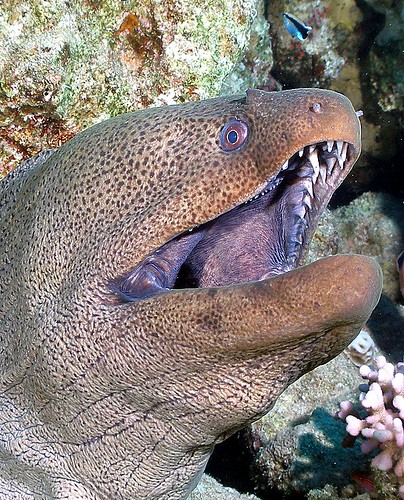
Giant moray, Red Sea;
(Photo by Anel Van Veelen)
The longest species however is the slender giant moray (Strophidon sathete), which has been recorded to reach 4 metres in length. Unfortunately, the only free images I could find online are of dead specimens, so here's a sketch I found on FishBase instead.

Sketch of slender giant moray

And here is a picture of a freshly dead slender giant moray I got from a Japanese webpage. Based on some of the other images on the site, I believe the focus on this species had a culinary slant to it.
Moray eels are associated with reefs and rocky shores. They are typically nocturnal predators, feeding on crustaceans, fish, and octopus. As such, most species have an array of sharp teeth for grabbing and holding onto prey. The viper moray (Enchelynassa canina), another species which can grow in excess of 2 metres, has fangs so long that they protrude even when the eel's mouth is closed. Moray eels as a whole appear menacing, but the viper moray is certainly one of the scariest-looking.

Viper moray, Hawaii;
(Photo by Benthichi)
A minority of species, like the zebra moray (Gymnomuraena zebra), have flattened molariform teeth, more suited to crushing and crunching rather than grabbing and piercing. These eels tend to specialise on hard-shelled prey like crabs, clams, and sea urchins.
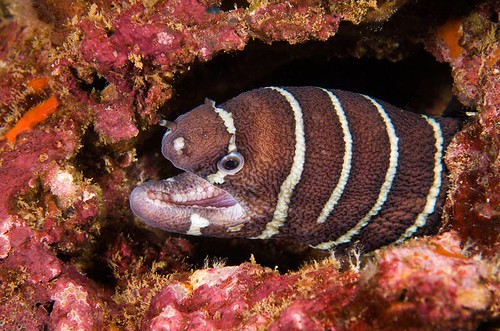
Zebra moray, Hawaii;
(Photo by cbabbitt)
Some species of moray eel actively forage for prey after dark, using their thin bodies to gain access to prey hidden in cracks and crevices. Others are ambush predators, waiting for prey to swim or crawl too close to their caves. As a whole, moray eels have an excellent sense of smell, but poor eyesight.
Moray eels have few predators, although groupers, barracudas and larger moray eels are known to prey upon them. They are eaten in some coastal communities, although the large species are sometimes implicated in cases of ciguatera poisoning.
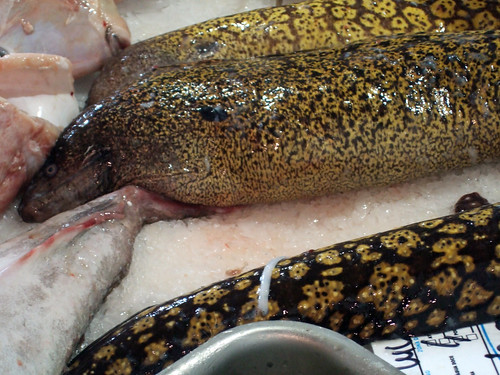
Mediterranean moray (Muraena helena) in fish market, Portugal;
(Photo by Marco di Pisa)
Despite their predatory nature, moray eels do strike up an interesting partnership with cleaner shrimps and wrasses (Labroides spp.), and it is not uncommon for divers to encounter a large moray eel at the entrance of its cave with its jaws open, while one or more tiny shrimps pick away at scraps of food and dead tissue in its mouth.

Whitemouth moray (Gymnothorax meleagris) with skunk cleaner shrimp (Lysmata amboinensis), Hawaii;
(Photo by wetfeetwhit)
Another very interesting partnership occurs in the Red Sea between the roving coral grouper (Plectropomus pessuliferus) and the giant moray. Both species are large predators, but have very different hunting strategies; groupers hunt in open water, so fish hiding from groupers will dive into narrow crevices. On the other hand, moray eels seek out prey hidden in crevices, and fish avoiding predation from moray eels head out into open water.
By performing a unique head-shaking signal in front of the moray eel, the grouper recruits the moray eel to join its hunting foray. The eel will emerge from its cave and follow the grouper, and will help to flush out prey hidden in places inaccessible to the grouper. By hunting cooperatively, both grouper and moray eel are able to benefit from the hunting strategy of the other species. Other species of groupers have been reported to associate with various moray eel species, but this is the most well-documented example of active cooperative hunting between these top predators of the reef, and is the first ever recorded instance of cooperative hunting between 2 species of fish.
Fishy Cooperation: Scientists Discover Coordinated Hunting Between Groupers, Giant Moray Eels
Two species cooperate to hunt
Bshary, R., Hohner, A., Ait-el-Djoudi, K. & Fricke, H. 2006. Interspecific Communicative and Coordinated Hunting between Groupers and Giant Moray Eels in the Red Sea. PLoS Biology 4(12), 2393-2398.
Strand, S. 1988. Following behavior: interspecific foraging associations among Gulf of California reef fishes. Copeia, 1988(2), 351-357.
Diamant, A. & Shpigel, M. 1985. Interspecific feeding associations of groupers (Teleostei: Serranidae) with octopuses and moray eels in the Gulf of Eilat (Agaba). Environmental Biology of Fishes, 13(2), 153-159.
Dubin, R. E. 1982. Behavioral Interactions between Caribbean Reef Fish and Eels (Muraenidae and Ophichthidae). Copeia, 1982(1), 229-232.
Karplus, I. 1978. A Feeding Association between the Grouper Epinephelus fasciatus and the Moray Eel Gymnothorax griseus. Copeia, 1978(1), 164.
As if their mouths lined with sharp teeth were not fearsome enough, in 2007, it was discovered that moray eels have not 1, but 2 sets of jaws with which to bite their prey. Studies of the reticulate moray (Muraena retifera) show that it actually possesses a second set of mobile jaws in its throat. Many fish possess what are known as pharyngeal jaws, but in moray eels, these jaws actually project forward when the moray eel seizes its prey, helping to get a more secure grip on the victim. The pharyngeal jaws then retract, bringing the prey item into the throat. It's impossible not to draw comparisons with the titular characters from the Alien series of movies. A bizarre (and totally awesome) case of life paralleling Hollywood special effects.

Pharyngeal jaws of a moray eel
(Image by Zina Deretsky, taken from Wikipedia)

And here's an X-ray of a moray eel showing the movement of the pharyngeal jaws.
Bony fish rely on suction to capture and swallow prey; suddenly opening the mouth results in prey being practically inhaled. But such a method requires ample room to allow for the expansion of the head when this occurs, a luxury not always present in tight crevices where moray eels often corner their prey. And so, it is thought that the mobile pharyngeal jaws are an adaptation which enables the moray eel to capture its prey effectively.
Mehta, R. S. & Wainwright, P. C. 2007. Raptorial jaws in the throat help moray eels swallow large prey. Nature 449(7158), 79-82.
Mehta, R. S. & Wainwright, P. C. 2008. Functional morphology of the pharyngeal jaw apparatus in moray eels. Journal of Morphology, 269(5), 604-619.
Moray Eels Are Uniquely Equipped to Pack Big Prey Into Their Narrow Bodies
Moray Eels Grab Prey With "Alien" Jaws
Bite Me... Twice
If the First Bite Doesn't Do It, the Second One Will
Much is unknown about the reproduction of moray eels; observation of some species indicates that moray eels release their eggs and sperm into the water. Like many other marine fish, moray eel larvae are pelagic, spending some time drifting with the plankton. Subsequently, they grow into transparent larvae known as leptocephali, a stage they share in common with other eel families, before finally maturing into miniature versions of their parents and settling down in a suitable area.
These predatory fish, especially the larger species, are a great draw for many scuba divers. Being quite sedentary in nature, many popular dive spots have a resident moray eel. Like sharks and barracudas, they have a reputation for being vicious and dangerous. It is often claimed that the Romans often raised moray eels on a diet of slaves! However, most divers who encounter moray eels soon learn that they are not aggressive, and in some cases, are even shy and retiring.
Moray eels often become habituated to the presence of people, and may appear curious and docile, even friendly. Unfortunately, this has led some divers to take certain liberties with moray eels. Undesirable behaviours such as manhandling of eels, petting, deliberate harassment, and even hand-feeding does occur, and when the eel lashes out in self-defence, the consequences can be messy and painful. Those sharp teeth, which have evolved to get a firm grip on wriggling prey, can do a lot of damage to skin and muscle, and the bacteria in a moray eel's mouth can cause nasty secondary infection. The really large species, by virtue of sheer size and a willingness to assert themselves, can become quite dangerous when provoked.
Barreiros, J. P. & Haddad Jr., V. 2008. Bite by moray eel. Journal of Venomous Animals and Toxins including Tropical Diseases. 14(3), 541-545.
This next video shows what happens when people forget that moray eels are wild predatory fish. A diver in Phuket feeds cocktail sausages to a giant moray, and when the moray demands more food, a thumb gets confused for a sausage. WARNING: Do not watch if you are squeamish.
Moray eels are common in public aquaria. There is also some demand for moray eels as pets, although the trade is usually limited to the smaller and more attractively coloured species. Even so, most of the moray species kept in aquaria do require plenty of space. Given their habit in the wild of hiding in caves, ample hiding places are another necessity in a captive setting. Moray eels are experts in finding ways to escape their tanks, so a secure cover is required.
Moray eels in the aquarium can be weaned onto a diet of fish, shrimp, and squid, although some individuals might insist on live food for some time. Being messy eaters, an aquarium with a moray eel definitely requires a very good filtration system. If all goes well, moray eels can be quite long-lived; some are thought to have a lifespan of up to 30 years or more.
As for tankmates, a moray eel is generally safe with fish too large to fit into its huge maw. Great care however must be paid to avoid fish that might actively harass the eel, or compete with the eel for food. Large angelfish (F. Pomacanthidae), groupers (F. Serranidae), and lionfish (F. Scorpaenidae) are some suitable tankmates. Moray eels are definitely not suitable for aquariums with crustaceans or small fish.
The next few photos feature some of the smaller moray eels which can be found in the home aquarium trade.
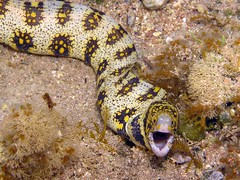
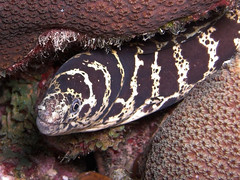
Left: Snowflake moray (Echidna nebulosa), Red Sea;
(Photo by prilfish)
Right: Chain moray (Echidna catenata), Bonaire;
(Photo by mrtexdiver)

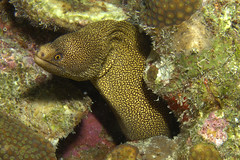
Left: Greyface moray (Gymnothorax thyrsoideus), Semporna;
(Photo by danielguip)
Right: Goldentail moray (Gymnothorax miliaris), Bonaire;
(Photo by VA Terp)
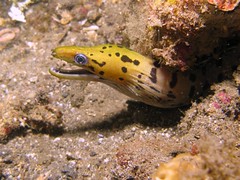

Left: Fimbriated moray (Gymnothorax fimbriatus), Bitung;
(Photo by friscodive)
Right: Zebra moray, Boracay;
(Photo by SWBatzer)
The snowflake moray and zebra moray are the most commonly available species. Both species don't get very large, are not aggressive, and are relatively easy to keep in captivity.

There is also a rare and very attractive golden morph of the goldentail moray that is nearly completely yellow in colour.
(Photo by Jill the Dog)
Two very distinctive species of moray eel are also encountered in the aquarium trade, the ribbon moray (Rhinomuraena quaesita), and the dragon moray (Enchelycore pardalis).

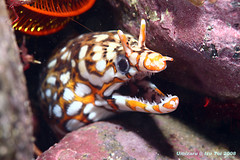
Left: Blue ribbon moray, Fiji;
(Photo by Giles Winstanley)
Right: Dragon moray, Izu;
(Photo by UmizaruGoh)
Interestingly enough, while most moray eel species do not take part in the bizarre sex-changing shenanigans commonly seen in other marine fish families, the blue ribbon moray is unique in being protandrous. All members of this species start out as males. Juveniles are completely black with a bit of yellow on the dorsal fin. When they mature, they turn bright blue with a yellow nose and lower jaw. As they age further, their coloration changes, becoming completely yellow and these males actually turn into females.
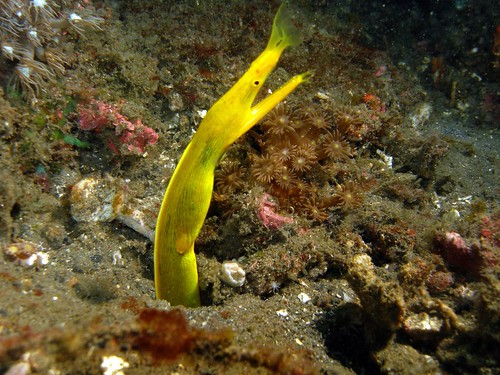
Female ribbon moray, Lembeh;
(Photo by maccdc)
The dragon moray is quite shy, and rarely encountered in the wild. In the aquarium trade, it commands a very high price; a quick search on Google reveals that dragon morays sell for at least US$1000 each. A highly aggressive species, this moray eel is best kept alone.
Both species are not recommended for the novice. While the dragon moray does adapt to life in captivity, probably because of the great amount of care and attention from aquarists serious enough to part with US$1000, it seems that the ribbon moray is one of those species that simply doesn't do well in captivity. This species seems quite fragile and delicate, and many otherwise healthy ribbon morays imported for the aquarium trade refuse to eat and simply waste away. Most ribbon morays don't survive beyond a month in a home aquarium.
In this case, the aquarium trade, if not regulated, might pose some threat to these 2 species. The high demand for dragon morays means that it is likely that a number of eels are removed before they reach breeding age. While I don't think collection for the pet trade is a significant threat to this widespread species as a whole, it is possible that overcollection might lead to the collapse of some populations.
Because of the ribbon moray's unique appearance and beautiful coloration, it is likely that many unsuspecting people buy the eel without being aware of the difficulty faced by aquarists in keeping this species alive in captivity for any length of time. Dealers may capitalise on the eel's beauty and delicate nature by constantly bringing in new stock to replace those that perish in customers' homes. Or they might offload the ribbon morays onto their customers without ensuring that the eels are healthy and feeding well first. Buyers who don't do their homework and buy on impulse also help to drive demand.
Moray eels are predominantly marine, but some species will enter brackish water. 3 species are even known to be capable of living in freshwater, and are marketed as freshwater moray eels.



Left: Freshwater moray (Gymnothorax polyuranodon);
(Photo by aqualifestyle_world)
Centre Estuarine moray (Gymnothorax tile);
(Photo by aqualifestyle_world)
Right: White-cheeked moray (Echidna rhodochilus);
(Photo by Johnny Jensen)
While it is true that these so-called freshwater moray eels can survive for some time in freshwater, they do much better under brackish to fully marine conditions, a situation identical to that faced by many other brackish water fishes kept in aquaria.
Several species of moray eels are known to occur in Singapore; the Wild Fact Sheet on the family lists 12 species, although I won't be surprised if many more species have not been recorded.
Moray eels are quite rarely encountered on our exploration trips to the shore. Maybe they're too good at hiding, or they stay away from the intertidal zone. The 2 species spotted by us so far are the estuarine moray and brown-spotted moray (Gymnothorax reevesii).
The estuarine moray has been seen on both our northern and southern shores, while the brown-spotted moray has been encountered on northern shores, on Beting Bronok and Chek Jawa.


Left: Estuarine moray eel, Cyrene Reef;
(Photo by Marcus)
Right: Brown-spotted moray, Beting Bronok;
Moray eels are rarely if ever seen on our trips to our shores, but there is another family of eels which we do encounter quite often, and which does have many members in Southeast Asian waters. These are the snake eels, which I will cover in the next post.
Part 1: Moray eels (Muraenidae) (this post)
Part 2: Snake eels (Ophichthidae)
Part 3: Conger eels (Congridae) and Pike conger eels (Muraenesocidae)
Part 4: Freshwater eels (Anguillidae)
Part 5: Spaghetti eels (Moringuidae) and false moray eels (Chlopsidae)
Part 6: Non-eels